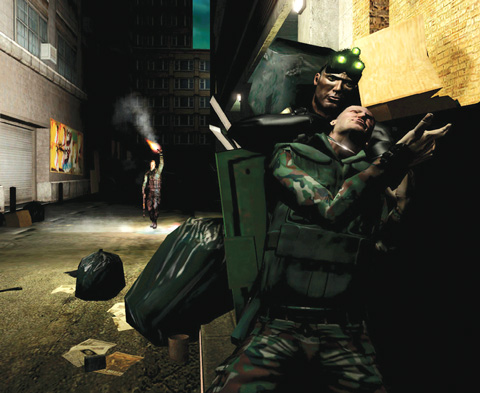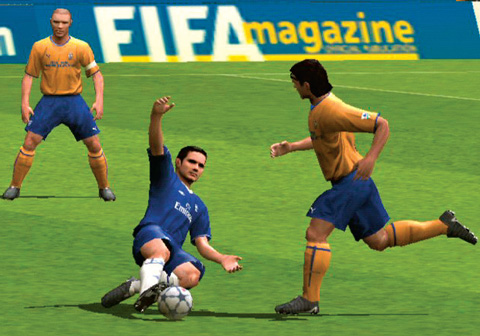People who work behind the scenes in the world of video games aren’t household names, but that doesn’t make their jobs any less enticing. Those who work long hours and sacrifice a lot of time to create games out there have admitted they do it because they’re gamers first.
UBISOFT GAMER, CLINT
 Clint Hocking works at Ubisoft in Montreal and currently juggles his duties as creative director, scriptwriter and lead level designer for Splinter Cell: Chaos Theory. Clint openly admits that he “was a little lucky and in the right place at the right time,” after a friend emailed him a link for a job opening at Ubisoft. “I’ve heard terrible stories of how some of the best designers in the industry took years to get their foot in the door, but lucky ones like me sent in one resumé, and bang! I was in,” Clint says. “I would say that the stories of struggle appear to vastly outnumber the stories of the lucky ones like me, but who knows? In the end, there are a lot of people who want to be game designers, and who are sure they would be great at it. But the fact is that it’s just as difficult and technical as being a graphics engine programmer.”
Clint Hocking works at Ubisoft in Montreal and currently juggles his duties as creative director, scriptwriter and lead level designer for Splinter Cell: Chaos Theory. Clint openly admits that he “was a little lucky and in the right place at the right time,” after a friend emailed him a link for a job opening at Ubisoft. “I’ve heard terrible stories of how some of the best designers in the industry took years to get their foot in the door, but lucky ones like me sent in one resumé, and bang! I was in,” Clint says. “I would say that the stories of struggle appear to vastly outnumber the stories of the lucky ones like me, but who knows? In the end, there are a lot of people who want to be game designers, and who are sure they would be great at it. But the fact is that it’s just as difficult and technical as being a graphics engine programmer.”
Clint earned a diploma in visual fine arts at Langara College in Vancouver, along with a master’s degree in creative writing at the University of British Columbia. Clint also attributes his experience as a writer and producer in independent films as “something that probably looked pretty good on my resumé.”
“Way back when I was in school, there weren’t many schools offering courses in game design, or even in 3-D art or graphics,” Clint says. “But the most important thing I learned in school was ‘how to learn,’ and in my mind, that is the real value of an education as far as becoming a game designer is concerned. It’s a career that will ask you to learn five years’ worth of new things every six months, and you have to be prepared to absorb that information.”
Clint Hocking, Creative Director for Ubisoft and one of his concepts for the game based on the script he wrote for Splinter Cell: Chaos Theory.

ELECTRONIC ARTS GAMER, JUSTIN
For Justin at Electronic Arts, another gaming company, the road wasn’t as smooth, especially since he left a multimedia school in his first semester to go job-hunting. After canvassing all his teachers, who were industry veterans, he attended recruitment sessions hosted by local companies. It was there that he landed a job as a local game developer in Vancouver. His next six years were then spent trying to convince his bosses to use his ideas in their games.
Now, he’s in his third year at Electronic Arts as an associate producer, working with an eclectic mix of people. “The difference for me, when I look to staff my design team, is the life skills. Can you negotiate? Can you boil down crazy ideas into workable solutions? Can you recognize a good idea — even if it came from that guy who chews with his mouth open — and run with it like it’s your own?” Justin says. “It’s all about loving games, loving creativity, and being able to put your head down, and putting a good idea on paper, in enough detail that the smart and talented folks can make it happen.”
When Justin started, the gaming industry was a lot different behind the scenes as well as in mainstream pop culture because the size and scope of games, in terms of money and design teams, were a fraction of what they are now. He also thinks current growth in the industry can provide many opportunities for anyone with a creative mind and strengths that range from Web design to creative writing. “It’s a tough job to find, but it’s getting easier,” he says. “I started as a gamer, and 10 years ago, my company didn’t have ‘designers’ — just artists, engineers and producers. Now, there are courses to take specifically in game design, not to mention stuff like the Internet — something I hadn’t heard about when I started.”
For getting into the business now, both Clint and Justin cite their education as a key factor. “Having a broad general education is pretty important because you can develop better creative tools,” Clint says. “You never know what kind of game you’re going to work on, so knowing a little bit about everything is only going to help.”
Need for Speed Underground 2 is EA’s way of delving into the glitzy underground world of street racing by mixing souped-up wheels within a gritty urban landscape.

FIFA Soccer from EA continues to impress soccer game players worldwide.

With FIFA Soccer, you are able to challenge more than 350 official licences, including 18 leagues, 40 national teams and 11,000 players.


What Do You Think? Leave A Comment!